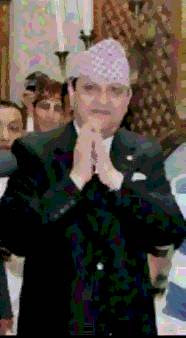 With grace and grit, the gloves finally came off.
With grace and grit, the gloves finally came off.Ex-king Gyanendra Shah, like much of the country and beyond, ended up seeing the monarchy as part of Nepal’s problem. In his own way.
A nation built against enormous odds bequeathed to this generation successive blows, testing the national will. Those intent on pushing its people further apart triumphed over advocates of unity. Nationalism became a dirty word. Nepal’s rich diversity came to be regarded as its unremitting blight. In a nation known for its people’s valor, victimhood took hold.
Still, pleas for patriotism persisted from its oldest institution. As always, these were interpreted as an offshoot from the monarchy’s alleged quest to perpetuate absolute power. Foreigners had their grudges against the monarchy. Their local enablers amplified the antipathy.
Gyanendra, like his predecessors, had identified the crux of the problem. There was a sustained campaign from abroad to pit the major political players against one another to foster chaos. Nothing would have stopped our waters from flowing south. With popular attention focused on a succession of villains, however, no one would have the time to set a per-cusec price and seek a share.
When it came to the vilification of the monarchy, the external playbook hardly ever changed. At the top was to expose the purported father-son conflicts over personal choice or policy outlook (Tribhuvan-Mahendra, Mahendra-Birendra, Birendra-Dipendra and Gyanendra-Paras). The next step was to identify and denigrate the black sheep in each generation (Basundhara, Dhirendra and Paras).
The trick lay in fitting those into Nepali realities so as to create a cover for real contests. The 1990s were propitious for democracy as an art as well as an ideal. Yet Nepalis were forced to accept it as an end. The hopes and aspirations raised by the 1990 changes played a big part in fueling the Maoist insurgency. Democratic leaders let the people voice all kinds of grievances but ensured for themselves the right not to listen. How long could they continue claiming credit for the sunshine and evading responsibility for the floods?
The Maoist insurgents capitalized on the crude games being played out in the name of democratic practice. The insurgency did not grow out of poverty and discrimination; there were far worse areas in the country than the mid-west, a region that actually benefited from integrated development projects. The Maoists became useful allies for the royalist right against the mainstream parties, whose monopoly over state resources ensured their dominance of the polity.
The Unified Marxist-Leninists accused the Nepali Congress of rigging the 1999 elections, ignoring the fact that it was part of the government. Yet both major parties saw the “working unity†between the royalists and the Maoists not against their depredations but against democracy itself.
Over time, the insurgents became more useful to the Indians, who were intent on perpetuating instability here. The Chinese, infuriated by this misappropriation of the Great Helmsman’s name, saw Nepal as a fertile base for the “containment†lobby ascendant in the West. The foreign minister at the time had spoken of a “new cold war†in Nepal.
The Narayanhity massacre took place at a time when the country was struggling to find its geopolitical locus. The surviving heir to the throne was a man who had strong views on the role of the monarchy and a stronger will to act on his beliefs. What better way to discredit him than to hold him complicit in the carnage?
As the monarch became more candid in the press, the Nepali Congress imploded amid internal strife. The prime minister recommended the dissolution of the legislature, and got his way. Months later, his political rivals recommended that the prime minister be dismissed for failing to hold elections. The monarch did that. But he refused to oblige the parties and, instead, sought greater power and influence to rectify the imbalance inherent the polity. Without changing so much as a punctuation mark in the constitution, he intensified his assertiveness.
The Maoists jumped in to strike a deal with the palace, bypassing the marginalized political parties. The palace-appointment governments were in no urgency to accept the Maoists’ terms. The rebels then began mending fences with the agitating political parties. Amid the triangular standoff, the insurgency grew more virulent, worrying the Chinese and Indians and emboldening the Americans.
When geopolitical compulsions necessitated a more decisive course correction, the monarch seized full control. Having failed to get their nominee as premier, the Indians reverted to their old trick of accusing the palace of flaunting “the China cardâ€. This time New Delhi had a more receptive audience in Washington. The Americans, who used this period of royal dominance to extend their legroom in South Asia, went along with the Indian line.
Gyanendra accomplished what his brother was on the verge of doing before he was eliminated. The international outrage, in this sense, was understandable. The leader of the world’s sole Hindu kingdom wore his religion on his chest. This was too much for the defenders of the world’s other faiths. Communist rebels became useful instruments not only for their ability to mobilize the masses but also for their ideological commitment to the secularization of the country.
The tide of popular protests rose amid a convergence of disparate international interests narrated in detail in previous posts. The Indians, sticking to their playbook, were still bargaining with the palace. The parameters were laid down by the draft treaty New Delhi had submitted to Birendra during the height of the 1990 protests. That single accord governing comprehensive relations with India gained new life.
Gyanendra, we are told, advised the Indians to go to Girija and Madhav and have it signed. They did that. The reinstatement of parliament produced an “historic proclamation†that remade the Nepali state. Still, the architects could not abolish the monarchy outright. With enough pressure, the king might just capitulate to external conditions.
In the guise of the peace process, India did extract concessions on the citizenship laws and river-development contracts. But the Chinese had become far more assertive and outspoken players. Those apprehensive of the military dimension of the Chinese railroad’s arrival in Lhasa saw Nepal as Beijing’s road to the South Asian heartland.
With Bangladesh and Sri Lanka having joined Pakistan in a wider collaboration with China to build strategic stability in South Asia, Nepal’s open border with India became a huge vulnerability. So the Madhes movement became a useful tool to blunt the Chinese.
If the Terai could be turned into something akin to the federally administered tribal regions of Pakistan, the Chinese juggernaut would desist from this “no-go†area. That way, Indian preponderance in the subcontinent could still stand a chance.
With no sign of the king capitulating, the country was declared a republic, which would be implemented by the first sitting of the constituent assembly. To ward off any royalist backlash, the ruling parties – with Indian blessings – empowered themselves to abolish the monarchy at any time if the palace was found to be “conspiring against the people.â€
The fissures in the Indian-American convergence on Nepal became clearer. Washington was not thrilled by the way the New Delhi government virtually subcontracted its Nepal policy to the communists. The Indians, too, recognized the limits of strategic partnership with the sole superpower.
On the surface, the UN Mission became the focus of this divergence. Yet in terms of economic, environmental, energy and other policies, the United States and India were far apart. Even in his state of “suspension,†the monarch was being wooed by both. By focusing attention on the “media ambush†of Maoist leader Prachanda existing the Indian Embassy, the ambassador could pursue his furtive meetings with the monarch.
Clearly, the proposals for a ceremonial monarch and a “baby†king were machinations to perpetuate instability. Up until the night the monarchy was formally abolished by the constituent assembly, the palace was being encouraged to accept certain “mutually beneficial termsâ€. A monarch forced onto the throne in crucial national circumstances twice had a greater sense of history.
In the aftermath of the vote, popular sentiments surfaced in unusual ways. When Nepalis were celebrating the close of a dark chapter, some of these same revelers were angered by an AFP reporter’s assertion that Nepal was once part of the British Empire. The problem wasn’t the message. It was the ferocity with which the messenger had always been struck.
In his farewell speech, Mr. Shah was circumspect in setting the record straight. He spoke of his personal anguish at the canards and calumny heaped on his family during his tenure as – mark the words – “head of stateâ€. He reiterated how “various reasons†had rendered his direct rule unsuccessful. Most importantly, he lamented how he had found no one to defend him.
During the ex-monarch’s final hours in the palace, the Nepali people got an opportunity to appraise the disgrace called the Fourth Estate, many members of which always considered themselves another set of royals. How poignant that the ex-monarch walked away with their halo as well.
As for the great Narayanhity whodunit, we may have to wait for that report stashed in some bank vault in Scotland. In the meantime, Citizen Gyanendra should find it much easier to play the principal part he never really could pursue while on the throne.




.png)










